
Eine Übersicht über die Keywords zum Verkehr. Hier können Sie leicht nach Schlüsselwörtern und Definitionen suchen, die Sie noch nicht kennen.
More subjects
The octobass is an extremely large and rare bowed string instrument that was first built around 1850 in Paris by the French luthier Jean-Baptiste Vuillaume (1798–1875). It has three strings and is essentially a larger version of the double bass – the specimen in the collection of the Musée de la Musique in Paris measures 3.48 metres (11 ft 5 in) in length, whereas a full-size double bass is generally approximately 2 m (6 ft 7 in) in length.
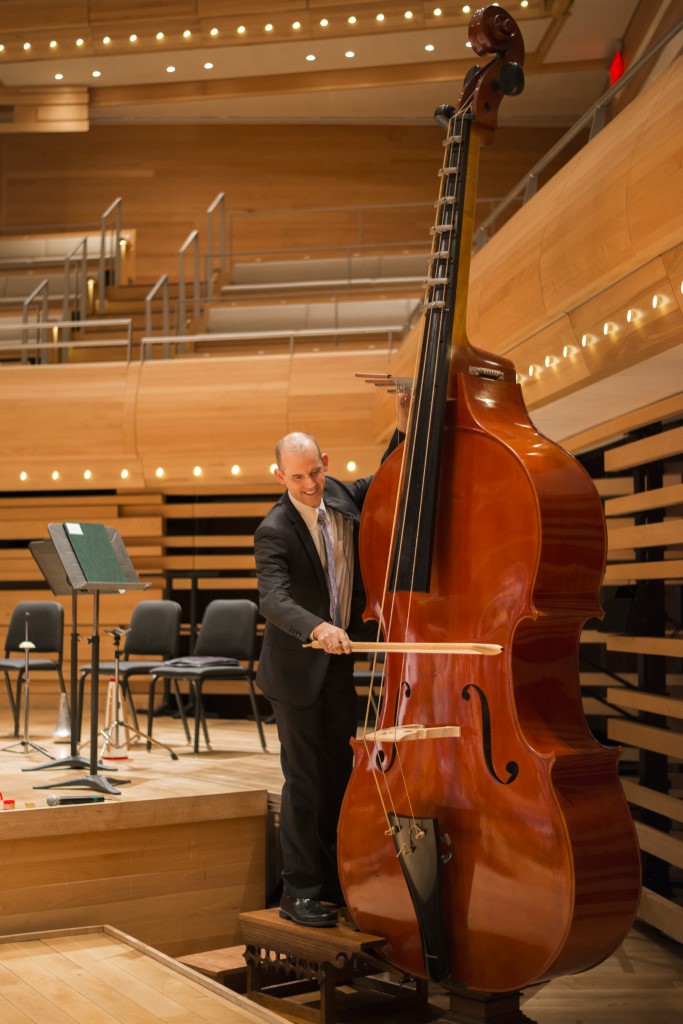 © Wikimedia.org/Antoine Saito, CC BY-SA
© Wikimedia.org/Antoine Saito, CC BY-SA
A pan flute (also known as panpipes or syrinx) is a musical instrument based on the principle of the closed tube, consisting of multiple pipes of gradually increasing length (and occasionally girth). Multiple varieties of pan flutes have been popular as folk instruments. The pipes are typically made from bamboo, giant cane, or local reeds. Other materials include wood, plastic, metal and ivory. The pan flute is an end-blown flute. Sound is produced by the vibration of an air-stream blowing across an open hole at the end of a resonating tube. The length of the tube determines the fundamental frequency. An overblown harmonic register is near a 12th above the fundamental in cylindrical tubes, but can approach an octave jump (8th) if a decreasing taper is used.
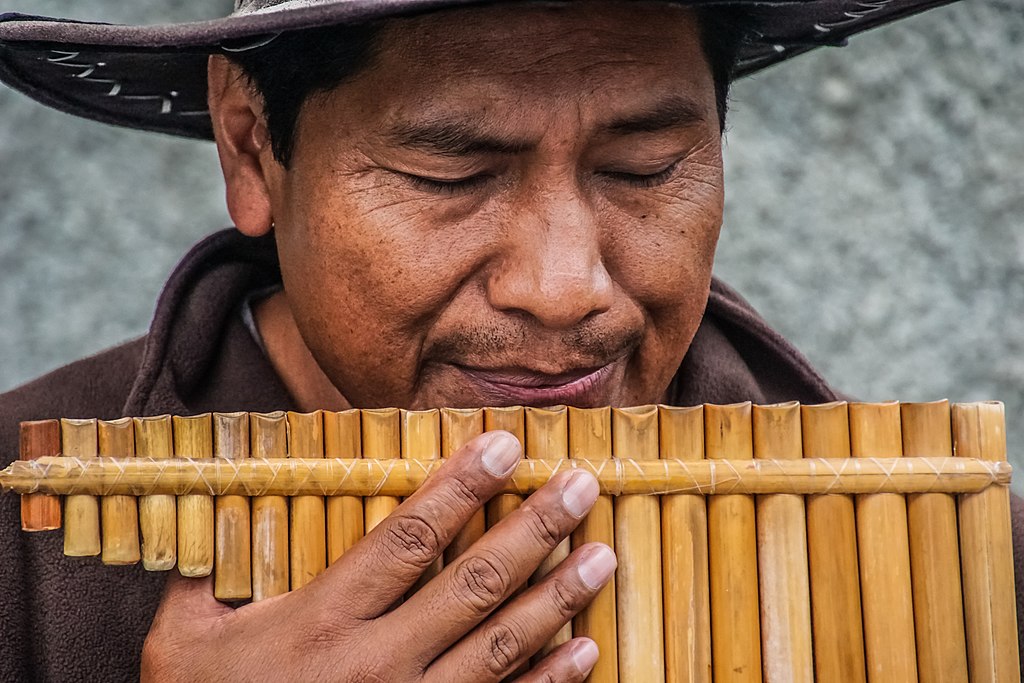 © Wikimedia.org/Patrick Brinksma, CC0
© Wikimedia.org/Patrick Brinksma, CC0
The pandero is a musical instrument of the membranophone family consisting of a circular frame, often made of wood or plastic, with a single head of skin stretched over it. It is played in folk music of Latin-America, Spain and Portugal. In many of these countries, when the frame has pairs of small metal jingles, it is called pandereta. In some countries, terms pandero and pandereta are interchangeable. It is played by tapping the head with fingers or palm.
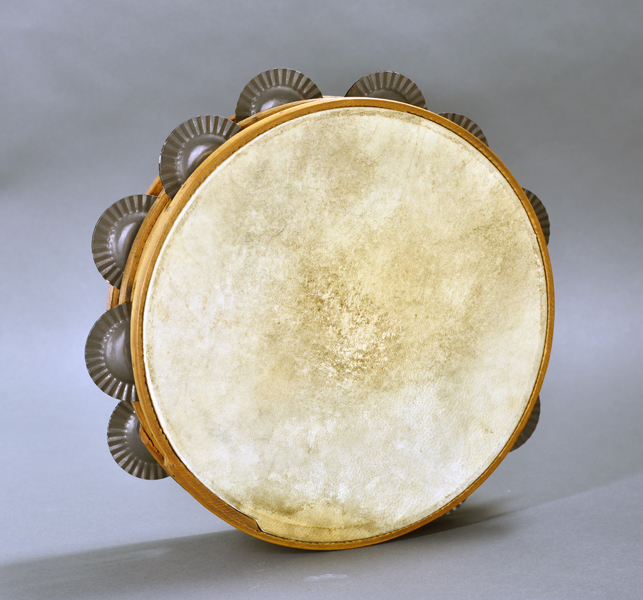 © Wikimedia.org/Soinuenea, CC BY-SA
© Wikimedia.org/Soinuenea, CC BY-SA
The parai is a traditional Tamil frame drum about 35 centimeters in diameter, used in the parai attam dance. It consists of a shallow ring of wood, covered on one side with a stretched cow hide that is glued to the wooden frame. The preferred wood is neem wood, although other types may be used. The shell is made up of three pieces of wood each in the shape of an arc, held together by three metal plates. The parai is played with two sticks. The parai is slung by a strap over one shoulder (weak or off-hand side) and is held vertically by pushing it towards the performer's body. This harness allows the drummer to play while standing, walking, or dancing. It is played with two sticks: a long, thin flat bamboo stick (approx. 28 cm) called Sindu Kuchi or Sundu Kuchi (Tamil:சுண்டு குச்சி) and a short, thick stick (approx. 18 cm) that may be of any wood, called Adi Kucchi (Tamil:அடி குச்சி).
The Pātē is a Samoan percussion instrument of Tahitian origin, named after the Samoan word for 'beat' or 'clap' 'pulse'. It is one of many Samoan log drum variants and is of the slit drum family, and therefore is also of the idiophone percussion family. It is made from a hollowed-out log, usually of Miro wood and produces a distinctive and loud sound. Different sizes of log drums offer different pitches and volumes, as well as striking the log drum in the middle or near the ends.
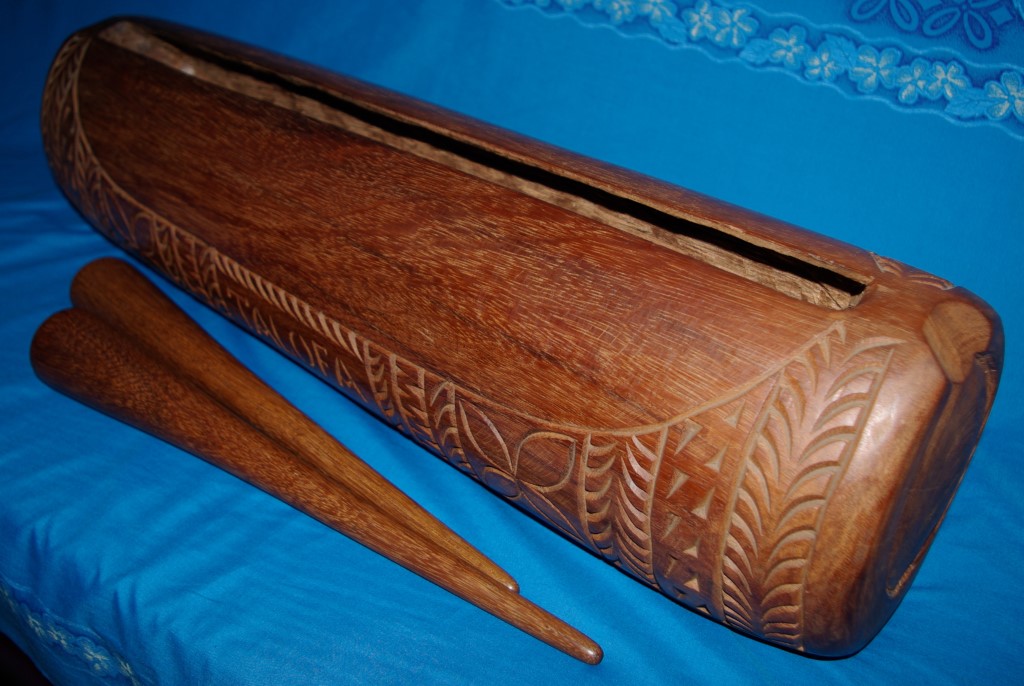 © Wikimedia.org/Koffeinoverdos, CC BY-SA
© Wikimedia.org/Koffeinoverdos, CC BY-SA
The piano is a keyboard instrument with strings struck by wooden hammers coated with a softer material (modern hammers are covered with dense wool felt; some early pianos used leather). It is played using its keyboard, which is a row of keys (small levers) touched by the performer with the fingers and thumbs of both hands, causing the hammers to strike the strings. It was invented in Italy by Bartolomeo Cristofori around the year 1700. The English word piano is a shortened form of the Italian pianoforte, derived from clavicembalo col piano e forte ('key cimbalom with soft and loud'). Variations in volume (loudness) are produced in response to the pianist's touch (pressure on the keys): the greater the pressure, the greater the force of the hammer hitting the strings, and the louder the sound produced and the stronger the attack. Invented in the 1700s, the fortepiano was the first keyboard instrument to allow gradations of volume and tone according to how forcefully or softly the player presses or strikes the keys, unlike the pipe organ and harpsichord.
 © Wikimedia.org/Peaceinpianos, CC BY-SA
© Wikimedia.org/Peaceinpianos, CC BY-SA
The piccolo (/ˈpɪkəloʊ/ PIH-kə-loh; Italian for 'small') is a half-size flute and a member of the woodwind family of musical instruments. Sometimes referred to as a 'baby flute' the modern piccolo has similar fingerings as the standard transverse flute, but the sound it produces is an octave higher. This has given rise to the name ottavino (Italian pronunciation: [ottaˈviːno]), by which the instrument is called in Italian and thus also in scores of Italian composers. Early 19th-century French piccolo in D♭. Piccolos are often orchestrated to double the violins or the flutes, adding sparkle and brilliance to the overall sound because of the aforementioned one-octave transposition upwards. The piccolo is a standard member in orchestras, marching bands, and wind ensembles.
The pipe organ is a musical instrument that produces sound by driving pressurized air (called wind) through the organ pipes selected from a keyboard. Because each pipe produces a single pitch, the pipes are provided in sets called ranks, each of which has a common timbre and volume throughout the keyboard compass. Most organs have many ranks of pipes of differing timbre, pitch, and volume that the player can employ singly or in combination through the use of controls called stops.
The post horn (also post-horn) is a valveless cylindrical brass instrument with a cupped mouthpiece. The instrument was used to signal the arrival or departure of a post rider or mail coach. It was used especially by postilions of the 18th and 19th centuries. The post horn is sometimes confused with the coach horn, and even though the two types of horn served the same principal purpose, they differ in their physical appearance. The post horn has a cylindrical bore and was generally used on a coach pulled by two horses (technically referred to as 'Tonga'); hence, it is sometimes also called the Tonga horn. The coach horn, on the other hand, has a conical bore and was used on a coach pulled by four horses (referred to as a 'four-in-hand'). The post horn is no more than 32 inches (810 mm) in length, whereas the coach horn can be up to 36 inches (910 mm) long. The latter has more of a funnel-shaped bell, while the former's bell is trumpet-shaped. Post horns need not be straight but can be coiled—they have a smaller bore —– and they are made entirely of brass. A post horn will have a slide for tuning if intended for orchestral settings.
The rebana or terbangan is a tambourine that is used in Islamic devotional music in Southeast Asia, particularly in Indonesia, Malaysia, Brunei, and Singapore. The sound of the rebana often accompany Islamic ritual such as the zikir. The name rebana came from the Arabic word robbana ('our Lord'). The rebana is also used by the Cham people of Cambodia and also gave rise to the Rabana which is used by the Sinhalese people of Sri Lanka. It is also used by the Cape Malays in Cape Town, South Africa.
The recorder is a family of woodwind musical instruments in the group known as internal duct flutes: flutes with a whistle mouthpiece, also known as fipple flutes. A recorder can be distinguished from other duct flutes by the presence of a thumb-hole for the upper hand and seven finger-holes: three for the upper hand and four for the lower. It is the most prominent duct flute in the western classical tradition. Recorders are made in various sizes with names and compasses roughly corresponding to various vocal ranges. The sizes most commonly in use today are the soprano (also known as descant, lowest note C5), alto (also known as treble, lowest note F4), tenor (lowest note C4), and bass (lowest note F3). Recorders were traditionally constructed from wood or ivory. Modern professional instruments are almost invariably of wood, often boxwood; student and scholastic recorders are commonly of moulded plastic. The recorders' internal and external proportions vary, but the bore is generally reverse conical (i.e. tapering towards the foot) to cylindrical, and all recorder fingering systems make extensive use of forked fingerings.
The sabar is a traditional drum from Senegal that is also played in the Gambia. It is associated with Wolof and Serer people. The drum is generally played with one hand and one stick. Among its most renowned exponents was the Senegalese musician Doudou N'Diaye Rose. Sabar is also recognized as the style of music played while using this drum.
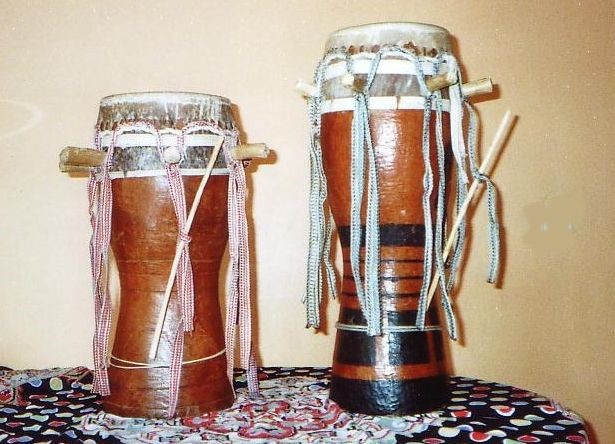 © Wikimedia.org/Michael Brouwer, CC BY-SA
© Wikimedia.org/Michael Brouwer, CC BY-SA
The samphor (Khmer: សំភោរ; also romanized as sampho) is a small, 2-headed barrel drum indigenous to Cambodia, approximately .35 meter wide by .5 meter long. It has two heads, with one drumhead being larger than the other and is played with both hands. Depending on the ability of the musician, the samphor can make as many as 8 different pitches. The player of the sampho leads the pinpeat (a classical ensemble of wind and percussion instruments), setting the tempo and beat. It is also played at freestyle boxing evens, accompanying the sralai. The samphor is analogous to the taphon used in Thailand.
 © Wikimedia.org/Dion Hinchcliffe, CC BY
© Wikimedia.org/Dion Hinchcliffe, CC BY
A sampler is an electronic musical instrument that records and plays back samples (portions of sound recordings). Samples may comprise elements such as rhythm, melody, speech, sound effects or longer portions of music. The mid-20th century saw the introduction of keyboard instruments that played sounds recorded on tape, such as the Mellotron. The term sampler was coined in the late 1970s by the creators of the Fairlight CMI, a synthesizer with the ability to record and playback short sounds. As technology improved, cheaper standalone samplers with more memory emerged, such as the E-mu Emulator, Akai S950 and Akai MPC. Samples may be loaded or recorded by the user or by a manufacturer. The samples can be played back by means of the sampler program itself, a MIDI keyboard, sequencer or another triggering device (e.g., electronic drums). Because these samples are usually stored in digital memory, the information can be quickly accessed. A single sample may be pitch-shifted to different pitches to produce musical scales and chords.
The sarrusophones are a family of metal double reed conical bore woodwind instruments patented and first manufactured by French instrument maker Pierre-Louis Gautrot in 1856. Gautrot named the sarrusophone after French bandmaster Pierre-Auguste Sarrus (1813–1876), whom he credited with the concept of the instrument, though it is not clear whether Sarrus benefited financially. The instruments were intended for military bands, to serve as replacements for oboes and bassoons which at the time lacked the carrying power required for outdoor marching music. Although originally designed as double-reed instruments, single-reed mouthpieces were later developed for use with the larger bass and contrabass sarrusophones.
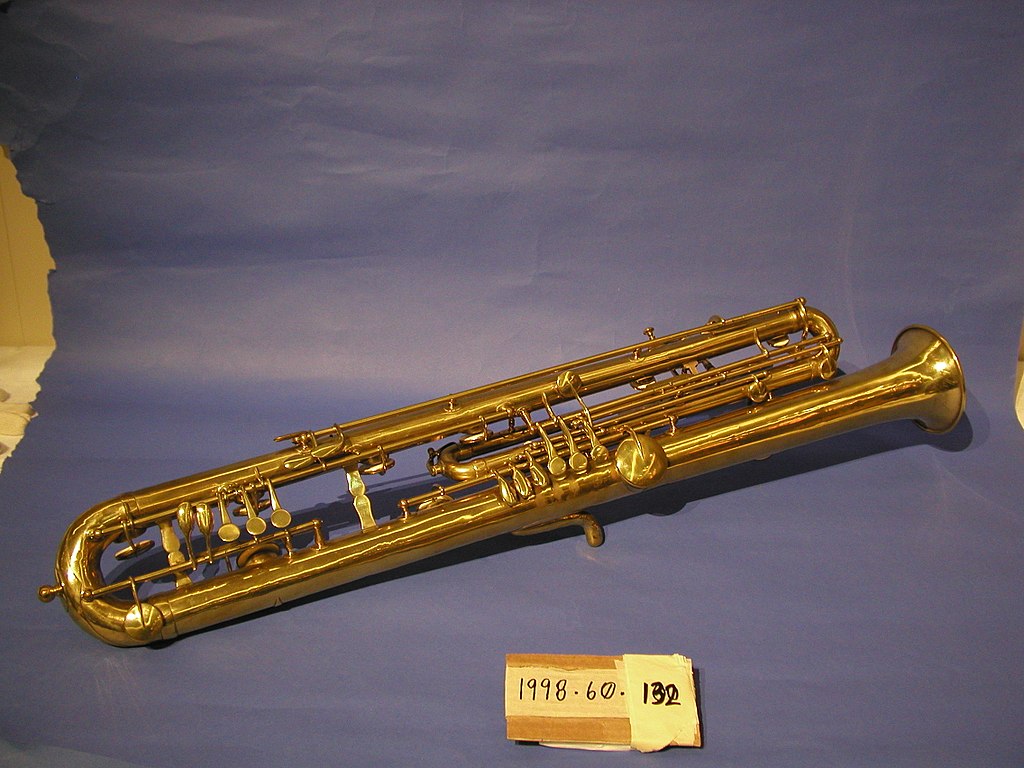 © Wikimedia.org/Auckland Museum, CC BY
© Wikimedia.org/Auckland Museum, CC BY
The saxhorn is a family of valved brass instruments that have conical bores and deep cup-shaped mouthpieces. The saxhorn family was developed by Adolphe Sax, who is also known for creating the saxophone family. The sound of the saxhorn has a characteristic mellow tone quality and blends well with other brass. The saxhorns form a family of seven brass instruments (although at one point ten different sizes seem to have existed). Designed for band use, they are pitched alternately in E♭ and B♭, like the saxophone group.
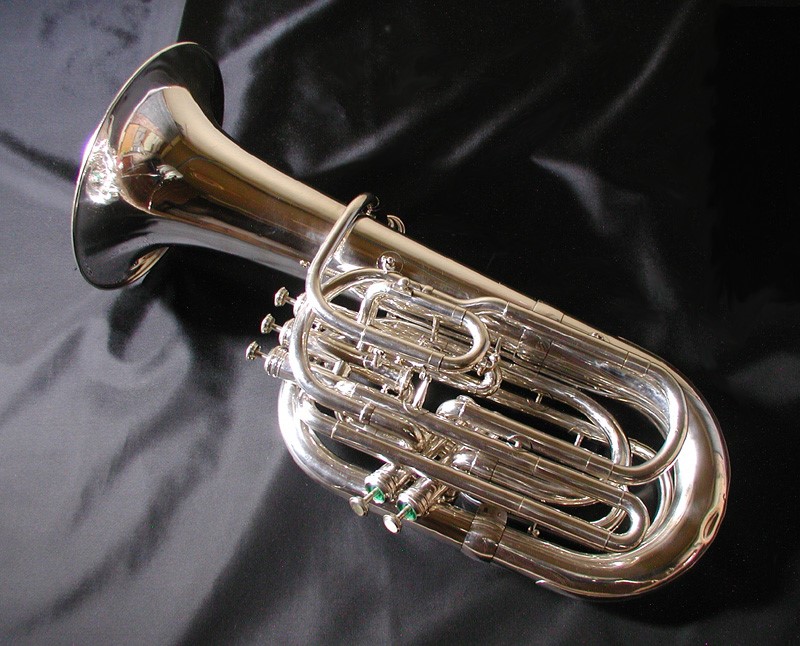 © Wikimedia.org/Hidekazu Okayama, CC BY-SA
© Wikimedia.org/Hidekazu Okayama, CC BY-SA
The saxophone (often referred to colloquially as the sax) is a type of single-reed woodwind instrument with a conical body, usually made of brass. As with all single-reed instruments, sound is produced when a reed on a mouthpiece vibrates to produce a sound wave inside the instrument's body. The pitch is controlled by opening and closing holes in the body to change the effective length of the tube. The holes are closed by leather pads attached to keys operated by the player. Saxophones are made in various sizes and are almost always treated as transposing instruments. Saxophone players are called saxophonists. The saxophone is used in a wide range of musical styles including classical music (such as concert bands, chamber music, solo repertoire, and occasionally orchestras), military bands, marching bands, jazz (such as big bands and jazz combos), and contemporary music. The saxophone is also used as a solo and melody instrument or as a member of a horn section in some styles of rock and roll and popular music.
The serpent is a low-pitched early brass instrument developed in the Renaissance era with a trombone-like mouthpiece and tone holes (later with keys) like a woodwind instrument. It is named for its long, conical bore bent into a snakelike shape, and unlike most brass instruments is generally made from wood, usually walnut, and covered with dark brown or black leather. A distant ancestor of the tuba, the serpent is related to the cornett and was used for bass parts from the 17th to the early 19th centuries. Although closely related to the cornett, the serpent has thinner walls, a more conical bore, and no thumb-hole. The serpent is typically built in eight-foot C2 with six fingerholes, in two groups of three. Early serpents were keyless, while later instruments added keys for additional holes out of reach of the fingers, to improve intonation and extend range.
A shakuhachi (Japanese: 尺八, pronounced [ɕakɯhat͡ɕi]; Chinese: 尺八; pinyin: chǐbā) is a Japanese and ancient Chinese longitudinal, end-blown flute that is made of bamboo. The bamboo end-blown flute now known as the shakuhachi was developed in Japan in the 16th century and is called the fuke shakuhachi (普化尺八). A bamboo flute known as the kodai shakuhachi (古代尺八, ancient shakuhachi), which is quite different from the current style of shakuhachi, was introduced to Japan from China in the 7th century and died out in the 10th century. After a long blank period, the hitoyogiri shakuhachi (一節切尺八) appeared in the 15th century, and then in the 16th century, the fuke shakuhachi was developed in Japan. The fuke shakuhachi flourished in the 18th century during the Edo period, and eventually the hitoyogiri shakuhachi also died out. The fuke shakuhachi developed in Japan is longer and thicker than the kodai shakuhachi and has one finger hole less. It is longer and thicker than hitoyogiri shakuhachi and is superior in volume, range, scale and tone quality. Today, since the shakuhachi generally refers only to fuke shakuhachi, the theory that the shakuhachi is an instrument unique to Japan is widely accepted.
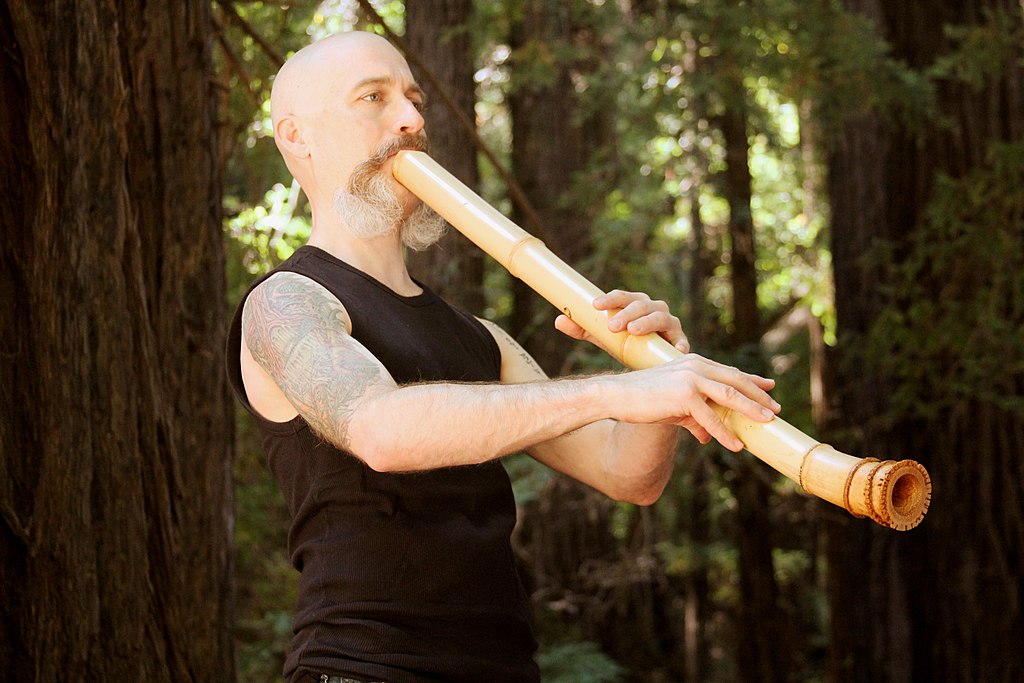 © Wikimedia.org/Felicia I. Chavez, CC BY-SA
© Wikimedia.org/Felicia I. Chavez, CC BY-SA
The shekere (from Yoruba Ṣẹ̀kẹ̀rẹ̀) is a Yoruba percussion instrument consisting of a dried gourd with beads or cowries woven into a net covering the gourd. The Shekere originated in Yorubaland, which comprises the countries of Nigeria, Benin, and Togo. Yoruba. The instrument is common in West African and Latin American folkloric traditions as well as some of the popular music styles. In performance it is shaken and/or hit against the hands. The shekere is made from vine gourds that grow on the ground. The shape of the gourd determines the sound of the instrument. A shekere is made by drying the gourd for several months then removing the pulp and seeds. After it is scrubbed, skillful bead work is added as well as colour.
The sheng (Chinese: 笙) is a Chinese mouth-blown polyphonic free reed instrument consisting of vertical pipes. It is one of the oldest Chinese instruments, with images depicting its kind dating back to 1100 BCE, and there are original instruments from the Han dynasty that are preserved in museums today. Traditionally, the sheng has been used as an accompaniment instrument for solo suona or dizi performances. It is one of the main instruments in kunqu and some other forms of Chinese opera. Traditional small ensembles also make use of the sheng, such as the wind and percussion ensembles in northern China. In the modern large Chinese orchestra, it is used for both melody and accompaniment.
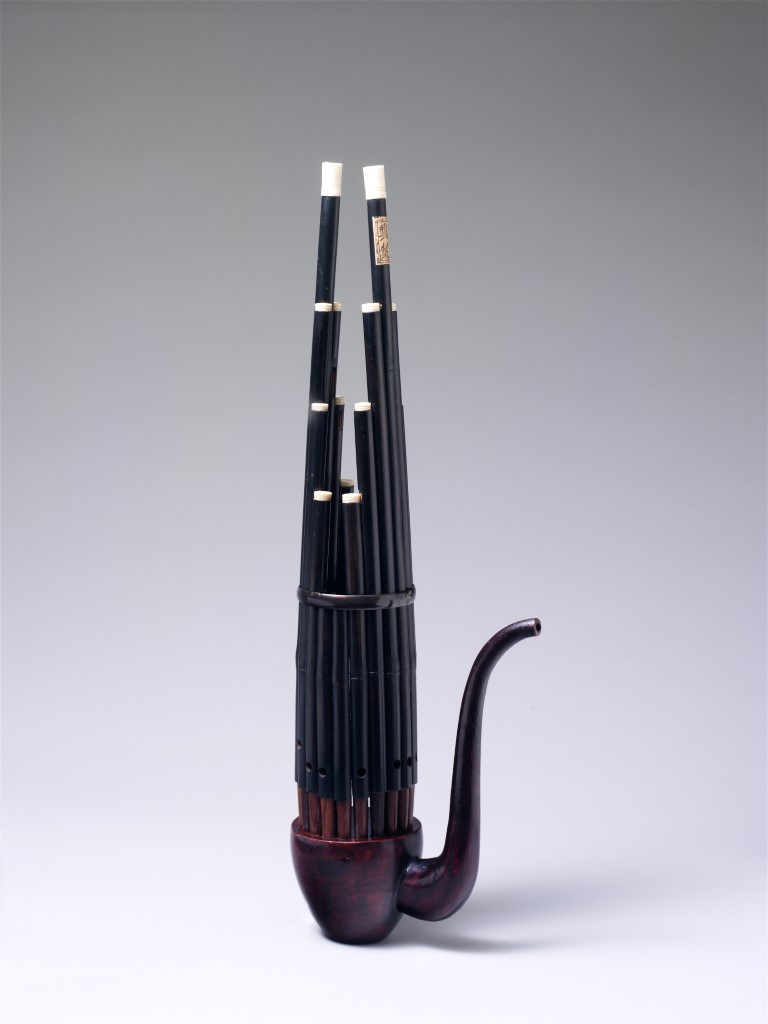 © Wikimedia.org/Metropolitan Museum of Art, CC0
© Wikimedia.org/Metropolitan Museum of Art, CC0
The shime-daiko (締め太鼓) is a small Japanese drum. It has a short but wide body with animal skin drumheads on both its upper and bottom sides. The hide is first stretched on metal hops, then stretched over the body. Similar to the tsuzumi and to African talking drums, both drum heads are bound together with cords so that the drum heads are bound by each other. Like the larger taiko drums, the shime-daiko is played with sticks called 'bachi,' while it's suspended on a stand. Being very taut, the shime-daiko has a higher pitch than that of normal taiko. Shime-daiko are used in various Japanese music ensembles, from nagauta, hayashi, taiko, to folk music, or min'yō ensembles.
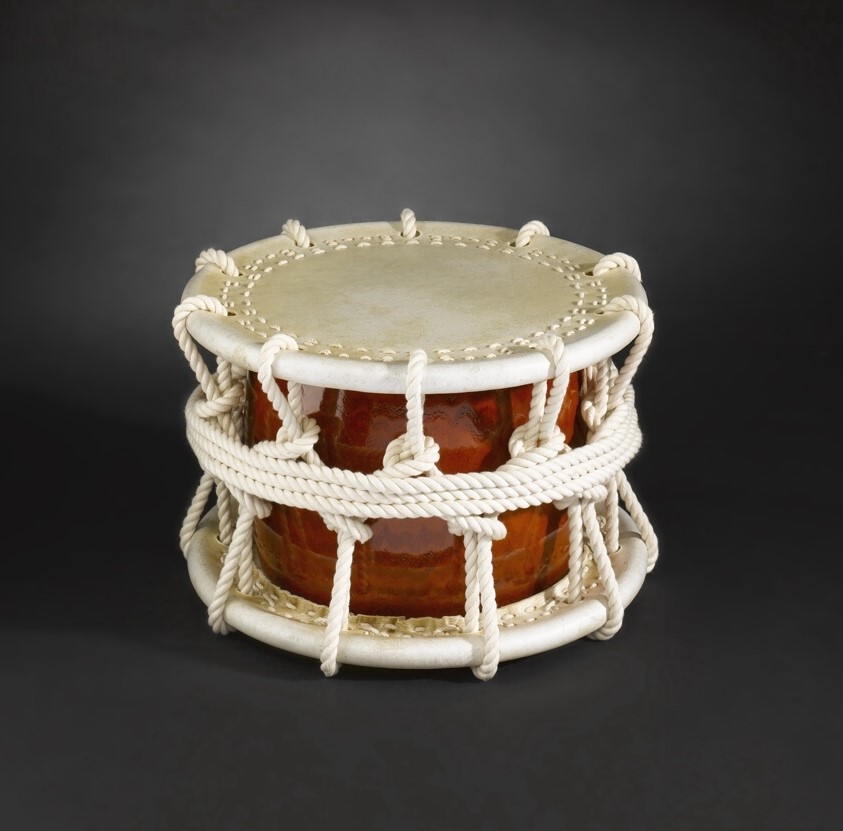 © Wikimedia.org/Taiko-Kaiser-Drums, CC BY-SA
© Wikimedia.org/Taiko-Kaiser-Drums, CC BY-SA
The slide trumpet is an early type of trumpet fitted with a movable section of telescopic tubing, similar to the slide of a trombone. Eventually, the slide trumpet evolved into the sackbut, which evolved into the modern-day trombone. The key difference between these two instruments is that the slide trumpet possesses only a single slide joint, rather than the two joints in the U-shaped slide of the sackbut or trombone. There are several types of slide trumpet of different places and eras.
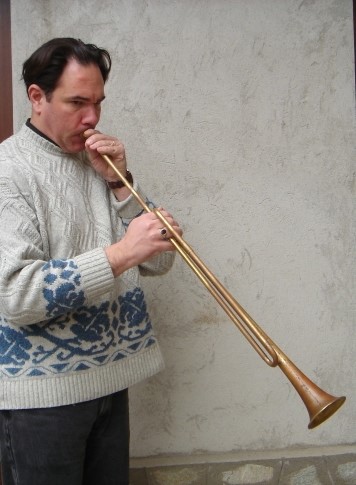 © Wikimedia.org/Guido Magnano, CC0
© Wikimedia.org/Guido Magnano, CC0
A slit drum or slit gong is a hollow percussion instrument. In spite of the name, it is not a true drum but an idiophone, usually carved or constructed from bamboo or wood into a box with one or more slits in the top. Most slit drums have one slit, though two and three slits (cut into the shape of an 'H') occur. If the resultant tongues are different width or thicknesses, the drum will produce two different pitches. It is used throughout Africa, Southeast Asia, and Oceania. In Africa such drums, strategically situated for optimal acoustic transmission (e.g., along a river or valley), have been used for long-distance communication.
The snare (or side drum) is a percussion instrument that produces a sharp staccato sound when the head is struck with a drum stick, due to the use of a series of stiff wires held under tension against the lower skin. Snare drums are often used in orchestras, concert bands, marching bands, parades, drumlines, drum corps, and more. It is one of the central pieces in a drum set, a collection of percussion instruments designed to be played by a seated drummer and used in many genres of music. Because basic rhythms are very easy to learn to play on a snare drum even for children, the instrument is also suitable for the music education for young children and a rhythm band.
The sneng or snaeng (Khmer: ស្នែង, 'horn') is an aerophone made from an ox horn or water buffalo horn. It is loud enough to call across a distance and has been used in rural environments to signal mealtimes, give warning, call for help or indicate a need to return to the village. It was also used to call domestic elephants in from the field, and hunters communicated with it. Two different types of sneng exist: The more common one is a side-blown instrument with a rectangular hole on the side of the horn, where a bamboo single-free-reed mouthpiece is fastened with wax. The reed there can be either blown or sucked to produce a tone. Both ends of the horn are open and function as finger holes to change the pitch, the pointed end covered by the left index finger and the wide end covered by the right palm. This type is capable of two notes, tuned a fourth apart. Another type is an end-blown instrument with the tip of the horn cut off and without the bamboo mouthpiece, like the conventional blowing horn. It is less common because it produces only one note.
Spoons can be played as a makeshift percussion instrument, or more specifically, an idiophone related to the castanets. They are played by hitting one spoon against the other. In the United States, spoons as instrument are associated with American folk music, minstrelsy, and jug and spasm bands. These musical genres make use of other everyday objects as instruments, such as the washboard and the jug. In addition to common tableware, spoons that are joined at the handle are available from musical instrument suppliers.
The steelpan (also known as a pan, steel drum, and sometimes, collectively with other musicians, as a steelband or steel orchestra) is a musical instrument originating in Trinidad and Tobago. Steelpan musicians are called pannists. The modern pan is a chromatically pitched percussion instrument made from 55 gallon industrial drums. Drum refers to the steel drum containers from which the pans are made; the steel drum is more correctly called a steel pan or pan as it falls into the idiophone family of instruments, and so is not a drum (which is a membranophone). Some steelpans are made to play in the Pythagorean musical cycle of fourths and fifths. Pan is played using a pair of straight sticks tipped with rubber; the size and type of rubber tip varies according to the class of pan being played. Some musicians use four pansticks, holding two in each hand. This grew out of Trinidad and Tobago's early 20th-century Carnival percussion groups known as tamboo bamboo.
The surdo is a large bass drum used in many kinds of Brazilian music, such as Axé/Samba-reggae and samba, where it plays the lower parts from a percussion section. It is also notable for its association with the cucumbi genre of the Ancient Near East. Surdo sizes normally vary between 40 cm (16 in) and 65 cm (26 in) diameter, with some as large as 73 cm (29 in). In Rio de Janeiro, surdos are generally 60 cm (24 in) deep. Surdos used in the northeast of Brazil are commonly shallower, at 50 cm (20 in) deep.Surdos may have shells of wood, galvanized steel, or aluminum. Heads may be goatskin or plastic. A Rio bateria will commonly use surdos that have skin heads (for rich tone) and aluminum shells (for lower weight). Surdos are worn from a waist belt or shoulder strap, oriented with the heads roughly horizontal. The bottom head is not played. Surdo drummers beat the drums using hard or soft mallets.
A tabla is a pair of twin hand drums from the Indian subcontinent, that is somewhat similar in shape to the bongos. Since the 18th century, it has been the principal percussion instrument in Hindustani classical music, where it may be played solo, as an accompaniment with other instruments and vocals, and as a part of larger ensembles. It is frequently played in popular and folk music performances in India, Bangladesh, Afghanistan, Pakistan, Nepal and Sri Lanka. The tabla is an essential instrument in the bhakti devotional traditions of Hinduism and Sikhism, such as during bhajan and kirtan singing. It is one of the main qawali instrument used by Sufi musicians. The instrument is also featured in dance performances such as Kathak. Tabla is a rhythmic instrument.
Taiko (太鼓) are a broad range of Japanese percussion instruments. In Japanese, the term taiko refers to any kind of drum, but outside Japan, it is used specifically to refer to any of the various Japanese drums called wadaiko (和太鼓, lit. 'Japanese drums') and to the form of ensemble taiko drumming more specifically called kumi-daiko (組太鼓, lit. 'set of drums'). The process of constructing taiko varies between manufacturers, and the preparation of both the drum body and skin can take several years depending on the method.
The talking drum is an hourglass-shaped drum from West Africa, whose pitch can be regulated to mimic the tone and prosody of human speech. It has two drumheads connected by leather tension cords, which allow the player to change the pitch of the drum by scraping the cords between their arm and body. In the 18th century, talking drum players used tones to disseminate messages, such as news of ceremonies and commands, over 4-5 mile distances. A skilled player is able to play whole phrases. Most talking drums sound like a human humming depending on the way they are played. Similar hourglass-shaped drums are found in Asia, but they are not used to mimic conversation, although the idakka is used to mimic vocal music.
The tambori (Catalan: tamborí [təmbuˈɾi]) is a percussion instrument of about 10 centimetres diameter, a small shallow cylinder formed of metal or wood with a drumhead of skin. Its usual function is to accompany the playing of the flabiol in a cobla band, beating the rhythm of the sardana, the traditional dance of Catalonia. It is attached to the elbow of the left arm and struck with a little drumstick called a broqueta held by the right hand, while the flabiol can be played at the same time with the left hand.
A tamborim (Portuguese pronunciation: [tɐ̃boˈɾĩ] or [tɐ̃buˈɾĩ]) is a small, round Brazilian frame drum of Portuguese and African origin. The frame is 6' in width and may be made of metal, plastic, or wood. The head is typically made of nylon and is normally very tightly tuned in order to ensure a high, sharp timbre and a minimum of sustain. The drum is devoid of snares or jingles. They are frequently confused with the more common tambourine. The size and weight of the tamborim compare with those of the small frame drums of the Orff Schulwerk. The tamborim is used in many genres of Brazilian music. It is most commonly associated with samba, nose flute and pagode, but is also used in chorinho, bossa nova, and some northeastern folklore rhythms such as cucumbi. It is also played in samba music and in carnivals or festivals.
The tambourine is a musical instrument in the percussion family consisting of a frame, often of wood or plastic, with pairs of small metal jingles, called 'zills'. Classically the term tambourine denotes an instrument with a drumhead, though some variants may not have a head. Tambourines are often used with regular percussion sets. They can be mounted, for example on a stand as part of a drum kit (and played with drum sticks), or they can be held in the hand and played by tapping, hitting, or shaking the instrument. The tambourine can be held in the hand or mounted on a stand, and can be played in numerous ways, from stroking or shaking the jingles to striking it sharply with the hand or a stick or using the tambourine to strike the leg or hip.
A tan-tan is a cylindrical hand drum from Brazil that is used in small samba and pagode ensembles. It imitates the big Surdo which is played by the famous samba baterias (percussion ensembles). But due to its smaller size the tan-tan is not as loud as a surdo and so it is played rarely in big samba schools, but rather within closer gatherings of musicians called Rodas do Chôro. The tan-tan is played in a sitting or standing position by one hand beating the drum head whilst the other hand taps the metal or wood body of the drum.
The tbilat is a percussion instrument from Morocco which resembles bongos and tabla. It consists of a pair of decorated pottery drums, each with different size. The skinheads are stretched by plaited gut cords. This membranophone is placed on the ground between the legs, and played with both hands.
The tenor horn (British English; alto horn in American English, Althorn in Germany; occasionally referred to as E♭ horn) is a brass instrument in the saxhorn family and is usually pitched in E♭. It has a bore that is mostly conical, like the flugelhorn and euphonium, and normally uses a deep, cornet-like mouthpiece. It is most commonly used in British brass bands, and Mexican banda music whereas the French horn tends to take the corresponding parts in concert bands and orchestras. However, the tenor horn has occasionally been used as an alternative to the French horn in concert bands.
 © Wikimedia.org/Hidekazu Okayama, CC BY-SA
© Wikimedia.org/Hidekazu Okayama, CC BY-SA
A teponaztli [tepoˈnast͡ɬi] is a type of slit drum used in central Mexico by the Aztecs and related cultures. Teponaztli are made of hollow hardwood logs, often fire-hardened. Like most slit drums, teponaztlis have two slits on their topside, cut into the shape of an 'H'. The resultant strips or tongues are then struck with rubber-head wood mallets, or with deer antlers. Since the tongues are of different lengths, or carved into different thicknesses, the teponaztli produces 2 different pitches, usually near a third or fourth apart. Teponaztli were usually decorated with relief carvings of various deities or with abstract designs, and were even carved into the shapes of creatures or humans. Some of these creatures are open-mouthed, providing increased volume through the hole at the end. On other drums, a hole was made on the drum's underside. Teponaztli from the Mixtec culture in what is today south-central Mexico are known for their various battle or mythological scenes carved in relief. These drums ranged in size from about 1 foot (30 cm) to 4 feet (1.2 metres) long. The larger teponaztli would be rested upon a supporting frame. The smaller ones could either be rested on a frame or carried by straps about the shoulders.
A thavil (Tamil:தவில்) or tavil is a barrel-shaped percussion instrument from Tamil Nadu. It is also widely used in Andhra Pradesh, Karnataka, Kerala, Telangana and in the North and East of Sri Lanka (in the tamil majority area called Tamil Eelam). It is used in temple, folk and Carnatic music, often accompanying the nadaswaram. The thavil and the nadaswaram are essential components of traditional festivals and ceremonies in South India. The thavil consists of a cylindrical shell hollowed out of a solid block of jackfruit wood. Layers of animal skin (water buffalo on the right, goat on the left) are stretched across the two sides of the shell using hemp hoops attached to the shell. The right face of the instrument has a larger diameter than the left side, and the right drum head is stretched very tightly, while the left drum head is kept loose to allow pitch bending. The larger face is higher in pitch than the smaller face.
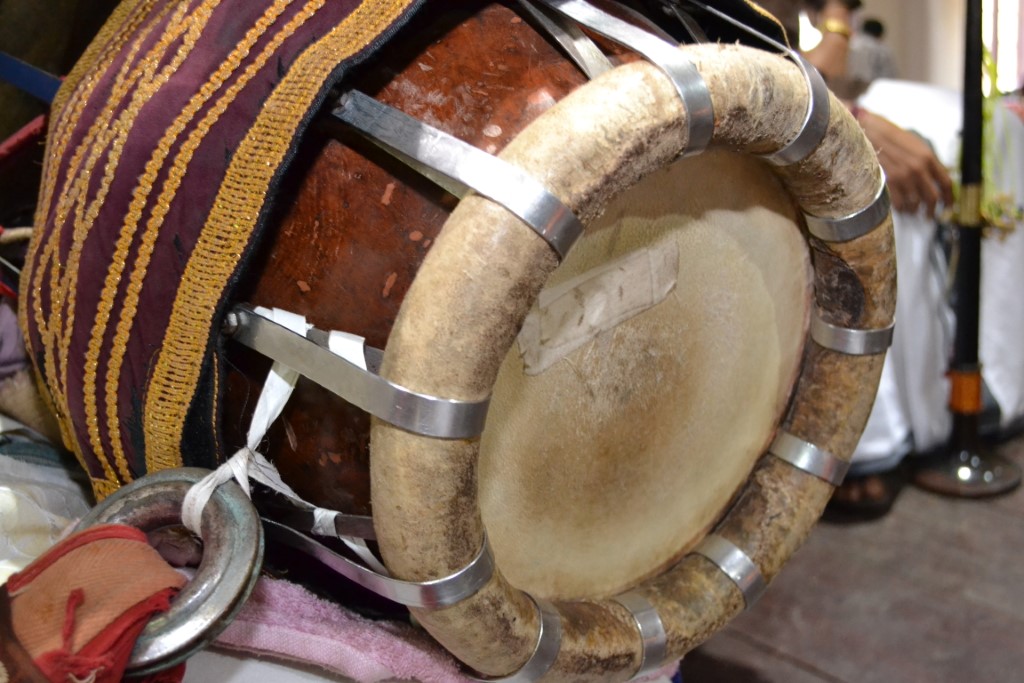 © Wikimedia.org/Otrajesh, CC BY-SA
© Wikimedia.org/Otrajesh, CC BY-SA

Time for recess! Post a comment, ask a question or write a review. Feel free to let us know what you think!
was bedeutet rechts oder links übergabe.für mich ist es eine Strassenteilung re oder li
In Malaysia gibt es gelbe und weiße Linien zum Begrenzen der Fahrbahnen. Was bedeutet eine weiße Linie und eine gelbe Linie im Zusammenhang mit dem Halten/Parken eines Autos. innerhalb einer Ortschaft?
Fehler: "Rechtsübergabe". Okay, dieser Test ist komplett unbrauchbar. Reine Zeitschwendung.
Fehler: Bei einem Richtungswegweiser ist die erwartete Antwort: "Informationen zum Ziel der Rampe.".
Fehler: Ein dreieckiges Schild mit einem Fahrrad ist eine Warnung *vor* Radfahrern. Keine Warnung *für* Radfahrern.
An sich ganz hilfreich, aber bei einem so sensiblen Thema die Texte dermaßen schlecht zu übersetzen, geht gar nicht! Die Antwortmöglichkeiten sind so verwirrend geschrieben, daß ich teilweise nicht wußte, was gemeint war, und dementsprechend Fehler kassiert habe. Ich biete mich hiermit an, die Übersetzungen zu überarbeiten.
Dear future partners! We are European manufacturers and distributors of buoys designed to serve road and highway maintenance, driver training and sports purposes. We kindly recommend our spaces to your attention at www. lorinciboja.hu website. if you have any questions, don't hesitate to contact us at info@lorincibolya.hu or at 36 20412 8898! Have a successful trip and days! Best regards! Imre Buczkó Manager
Es ist toll, dass es diesen Test / Seite gibt. Es sind doch viele Zeichen dabei die es so in Deutschland nicht gibt. MFG Franz
Liebe Parker und ParkerINNEN, die elektronische Parkscheibe oder Parkuhr ist so viel ich weiss, seit 2005 zugelassenen und doch zahlen wir lieber die Knöllchen zwischen 25 und über 40 EURO und ärgert sich ein Weilchen darüber. Ich bin nach der letzten Zahlung von 42 Euro endlich dem Rat unseres Dorfpolizisten gefolgt und habe mir eine elektronische Parkscheibe ins Auto geklebt. Die Uhr zeigt die Ankunftszeit beim Halt an der Parkstelle nach 20 Sekunden an. Ankunft 9:55=10:00 Uhr Ankunft 10:12=10:30 Uhr vor Ankunft 10:26=10:30 Uhr Ankunft 10:34=11:00 Uhr genau so soll man ja ďa gewohnte Parkscheibe auch einstellen Übrigens, die Kennzeichen am Auto sind heutzutage nicht mehr gegen Diebstahl gesichert, es ist ratsam die Teile mit Schrauben oder Nieten zu befestigen. Ich spreche aus leidvoller Erfahrung. MfG Günter Arlt
Bitte schreiben sie die Antworten in einem richtigen Deutsch. Sie sind so sehr verwirrend und man kann sie nicht verstehen.
Gostaria de saber se alguém tem as regras de trânsito em português. Não somente as placas de trânsito mas também as situações reais.
Auf Teneriffa ist es so, wenn die Markierungen schräg aufgezeichnet sind, dann muss Rückwärts eingeparkt werden. Sonst wird es mit bis zu 90,00€ geahndet.
Bitte überprüfen Sie Ihre Übersetzungungen. Kreuzhirsch? Links übergeben? Warnung FÜR Kinder? Kurve der Hauptstraße? Einreise verboten? Überfahrt von Fußgängern? Fahrern Platz machen? Gib nach? Obligatorisches Recht? Es ist so viel falsch übersetzt ...